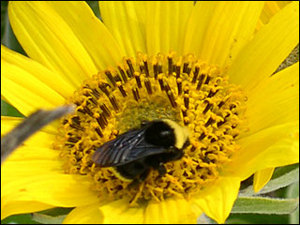
|
| ©Unknown |
Corvallis, Oregon -- From foraging techniques to pollen gathering patterens, bee behavior is the focus of many research projects at Oregon State University.
But the latest major discovery happened here by accident.
Entomologist Sujaya Rao was collecting grass seed pests with different colored traps, she expected one with a blue vane to be a bust.
"Only the yellow one was likely to work because yellow is very attractive to insects," said Rao. "But they were free. I put them out and when I went to collect data, the blue ones were full of bees. And it was very unexpected because there is no odor in there, just color."
But not just any blue.
Through another accident, Rao discovered bumblebees only swarmed to traps with florescent dye.
That's because bees see things on the ultraviolet spectrum, so the blue vane with florescent dye glows.
More research is needed, but Rao says it's an important discovery about bee vision that could help the bee population in Oregon.
Colony collapse disorder is killing off the honeybee population, which threatens many crops statewide.
Unfortunately, honeybees are not attracted to the florescent blue, but bumblebees are.
Researchers hope they can grow the bumblebee population by using the blue vanes to direct bees from one crop to the other.
"So if a crop is getting ready to bloom and we can say come here, there's lots of food," said Rao. "We can hasten the process of pollination."
The more food for bees, the bigger the colony can grow.
Rao says it will be a couple of years before their research is final and can be implemented in local fields.
In the meantime, growers can order the blue vanes for themselves.



I find it interesting to notice they authors are claiming that bees like the color blue is a new finding. Consider this quote from Maurice Maeterkinck's amazing book from 1901 'The Life of the Bee' where he is describing different colored apiaries:
"some he had painted bright pink, and some a clear yellow, but most of all a tender blue; having noticed, long before Sir John Lubbock's demonstration (in Ants, Bees and Wasps published 1882) the bees' fondness for this color."
Good to know the people trying to resolve the problem of CCD are well-versed in their subject, and are not just wasting their time rediscovering old knowledge........